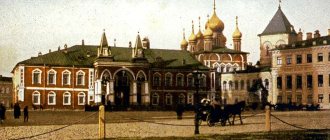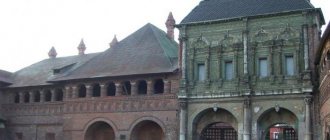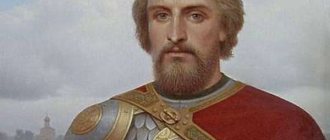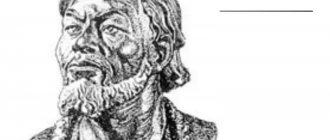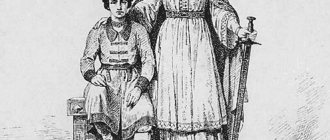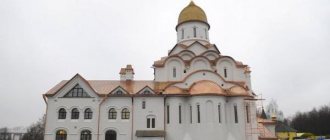Hilarion Rusin
, (+ 2nd half century), Metropolitan of Kiev and All Rus', Saint
Memory October 21, in the Cathedrals of St. fathers of the Kiev-Pechersk Near Caves and all the saints. fathers of the Kiev-Pechersk, as well as the Kyiv saints
He lived in the era of Grand Duke Yaroslav the Wise, the son of Saint Vladimir, Equal-to-the-Apostles. He entered the history of the Russian Orthodox Church as the first of its Russian primates appointed to the metropolis by the Council of Russian Bishops.
Saint Hilarion was born into the family of a Nizhny Novgorod priest and was himself a priest of the Church of St. Apostles in Berestov, a princely residence near Kiev, spiritual father and associate of Prince Yaroslav.
According to the Venerable Nestor the Chronicler:
“The God-loving Prince Yaroslav loved Berestovo and the Church of the Holy Apostles that was there, and he honored and supported many elders.
Among them was a presbyter named Hilarion, a good man, a scholar, and a faster. He walked from Berestov to the Dnieper, to the hill where the dilapidated Pechersky Monastery is now, and then he said a prayer in a dense forest. Having dug a small two-foot cave, coming from Berestov, he sang here for hours and prayed to God in solitude...” Subsequently, this cave was occupied by Anthony of Pechersky. Hilarion received monastic vows from St. Anthony.
Saint Hilarion, as his works testify, was not just a “man of books,” but possessed spiritual gifts and depth of theological knowledge. He devoted all his strength to serving the Church.
When Metropolitan Theopemptos died, Rus' was at war with Byzantium. By a conciliar judgment of the hierarchs of the Russian Church, it was decided to install a metropolitan in Kyiv, without turning to Constantinople, although the Russian Church was at that time a metropolis within the Patriarchate of Constantinople and its primates had previously been Greeks. Saint Hilarion was famous among the Russian clergy for the height of his spiritual life and his preaching talent. Not long before, in the Tithe Church, in praise of Saint Prince Vladimir, he delivered his famous “Sermon on Law and Grace,” in which he gave a theological understanding of the place of the Russian Church in the history of the Divine economy of salvation. This literary work testifies not only to the theological knowledge, but also to the rhetorical and literary talents of its author, which suggests that Hilarion received higher education in Byzantium. Participating in the embassy to the French royal court (c. 1048), he also had the opportunity to get acquainted with Western Europe.
The choice of the Council of Bishops was to the liking of Yaroslav the Wise. The ascetic was installed as Metropolitan of Kyiv in Hagia Sophia in 1051. Later, Saint Hilarion was confirmed by the Patriarch of Constantinople (according to other sources, he was never confirmed and his short reign is connected with this). His activities took place during the period of establishment and strengthening of Christianity in Rus'. To achieve success in this important undertaking, Metropolitan Hilarion attached great importance to the development of literacy.
During his reign, the stone church of the monastery of St. was consecrated on November 26, 1052 (1053). George in Kyiv, founded by Yaroslav.
The name of Hilarion is associated with the composition of the church charter (nomocanon) of Prince Yaroslav. However, this fact is questioned by scientists who attribute this nomocanon to later times (XII-XIII centuries) [1].
The chronicle did not note the year of his death, but at the burial of Prince Yaroslav the Wise, on February 20, 1054, the saint was no longer present, and in 1055 a new metropolitan, the Greek Ephraim, arrived in Kyiv.
The silence of the chronicle about the death of St. Hilarion gives reason to believe that he did not die, but was removed from the administration of the metropolis. The removal of Hilarion was apparently in connection with the restoration of the previous order of installation of Kyiv metropolitans and probably followed shortly after the death of Yaroslav in February 1054 [1]
The spiritual legacy he left lives on in the Russian Church. And, first of all, the best creation of ancient Russian church literature is “The Sermon on Law and Grace,” known in more than 50 copies of the 16th century. Among other works of Saint Hilarion, a particularly important place is occupied by his bishop's confession, which became a model of the episcopal oath in the Russian Church.
Saint Hilarion was buried in the Kyiv caves. In the inscriptions of his works, in handwritten calendars and catalogs of saints, Saint Hilarion is invariably called a saint and a wonderful miracle worker. The stable liturgical veneration of him as a saint is attested in the services of the Kiev-Pechersk monk. Both in the service to the Council of Fathers of the Near Caves (September 28) and in the service to all the Kiev-Pechersk saints (2nd Sunday of Great Lent), he is listed along with other holy hierarchs of the Russian Orthodox Church.
Historical and political prerequisites for the election of a metropolitan from among the Russians
The reason for the conflict, which developed into a real war between the Greeks and Russians during the reign of Yaroslav the Wise, was an incident related to merchants from Kievan Rus.
A merchant from Kyiv was killed in Constantinople, and the property that belonged to the deceased was confiscated in favor of the emperor. News of what happened quickly reached Kyiv and caused a storm of indignation among the ruling elite and, of course, directly among the prince. After all, shortly before this, negotiations were held stipulating similar situations and measures to resolve controversial issues, but the Greeks acted absolutely against the accepted agreements.
Military campaign against the Greeks
Prince Yaroslav sends an expeditionary force to the Eastern Roman Empire, headed by the prince's eldest son, who sets off by sea. Near the western shores of the Black Sea, the Slav squadron was caught in a big storm, losing more than a third of its ships. The remainder of the troops, moving by sea, were attacked by Greek ships. After such troubles, some of the ships still usable were sent back, landing troops. On the way back, the prince's ships were again overtaken by a Greek squadron, but this time luck was on the side of Prince Yaroslav's soldiers. The Greek ships were sunk in large numbers.
The six thousand soldiers who managed to land on the shore continued their campaign, led by the experienced commander Vyshata. The news of the destruction of the fleet infuriated Emperor Constantine Monomakh, so the issue of landing troops had to be resolved with maximum cruelty, according to the emperor’s plan.
After a series of clashes, Voivode Vyshata was surrounded and taken prisoner with the remnants of the detachment; in this case, the Greeks used very cruel punishment, which, in principle, had already been used in history; just remember Vasily II the Bulgarian Slayer. The remaining Russian soldiers were blinded and sent home; of course, such an act on the part of the Greeks did not help end the war.
The death of Metropolitan Theognostus as a prerequisite for the election of Hilarion
In 1048, Metropolitan Theognostus dies. Due to the crisis in Greek-Slavic relations, the new metropolitan cannot come to Rus'. It should be noted that before this all hierarchs were sent from Constantinople. Prince Yaroslav the Wise understands that the situation is critical and it is necessary to act quickly and firmly. Therefore, he decides to appoint a compatriot to the post of metropolitan without the permission of Byzantium. The choice falls on the monk of the Kiev Pechersk Lavra, the future first hierarch of the Russian Orthodox Church, who becomes Hilarion of Kiev.
Metropolitan Hilarion (1051-1054 or 1055) - brief biography
Saint Hilarion, first metropolitan
Kiev and All Russia
of Slavic origin.
Elected to the See of Hagia Sophia of Kiev of the Patriarchate of Constantinople by the Orthodox Council of Russian Bishops in
1051
.
Confessor and comrade-in-arms of Grand Duke Yaroslav the Wise. One of the founders of the Kiev-Pechersk Monastery in Kyiv. An outstanding statesman
and great
writer of Ancient Russia
.
Becoming
Very little is known about Saint Hilarion of Kiev. The information is taken from the Kyiv chronicles, the Tale of Bygone Years, as well as personal notes preserved in fragments. Was born
he was already after the official baptism of Russia by Prince Vladimir
, in 990
.
He was “a lover of God and learned to read and write.” I read a lot, knew Greek, studied theology and tried to pray in solitude. He dedicated his life to worship.
He labored as
a hieromonk of
the princely
church in the village of Berestovo,
consecrated to the glory of the Holy Apostles.
He served as the personal confessor of the Grand Duke
.
In his personal time, he often went to the banks of the Dnieper
, built himself a cave there, and
indulged in solitary prayer
.
It is believed that he received his education in Byzantium, and borrowed the hermitage while staying on Mount Athos. Not far from Hilarion’s cell, another hermit, Anthony of Pechersk, settled. the Kiev-Pechersk Cave Monastery was formed
on this site .
Hilarion developed
the Russian
church charter
, which expanded the capabilities and powers of the church.
New rules for conducting worship services,
different from the Greek ones.
Hilarion did a lot to establish the sovereignty and independence of Kievan Rus. He supported Prince Yaroslav
in the fight
against
the Byzantine Empire, he was fluent in the techniques of rhetoric, and wrote a lot.
It is known that Hilarion was part of the group accompanying Princess Anna during her trip to France in 1048. This mission allowed the theologian to visit Europe and get acquainted with its traditions and laws. Shortly before this, in 1040
, during a service,
Hilarion read
his first creation, “
The Sermon on Law and Grace.”
In it, the author commemorates Prince Vladimir, who conducted the general baptism.
And it shows the place of the Russian Church in the history of religion
, as well as the superiority of Orthodoxy over Judaism. The first work is followed by “Prayer”, “Confession of Faith”, “A Word on the Renewal of the Tithe Church”. Subsequently, fragments of the “Word” and “Prayer” were mentioned in the lists of fifty chroniclers of the 15th-16th centuries.
Elections
Since the baptism of Rus', it was considered the metropolis of Constantinople. The church was ruled by metropolitans of Greek nationality sent from Constantinople. They supported the policies of Byzantium and strongly opposed the strengthening of the Russian state. The Great Russian Prince Yaroslav the Wise decides to change this rule. At the Council of Russian Archbishops, Metropolitan of Kiev
was unanimously and rightfully
elected.
Constantinople opposed the choice, because the hieromonk did not have high ranks.
They did not contradict Yaroslav. The Metropolitan actively supported the policies of Yaroslav the Great
, which allowed Russia to grow stronger and continue to strengthen Orthodoxy.
During the metropolis, Hilarion emphasized education. Together with Yaroslav the Wise he is collecting literature,
and
the creation of a library in Sofia of Kiev
.
In addition to the “Sermon on Law and Grace,” his other works appeared during this period, for example: “The Legend of the Spread of Christianity in Rus'.” All his creations can be called the oldest Russian theological literature
.
Hilarion's reign ended with the death of Yaroslav in 1053.
The Metropolitan was no longer present at the farewell ceremony with the prince.
It is believed that after his elimination, he lived in the Kiev Pechersk Lavra
.
The canonization
of the Saint took place already
in 1980
.
The rapprochement of the future metropolitan and prince
Even before his monastic feat, Hilarion of Kiev was distinguished by his ascetic life, imitating the ancient anchorites.
Sources say that he dug himself a cave in the forest. In it he spent solitary hours in prayer. Subsequently, the monk Anthony settled there, returning from Athos. It was from this moment that Hilarion’s spiritual authority began to grow in the eyes of the population of ancient Kyiv. After some time, most likely in the 50s of the 11th century, people begin to resort to various pieces of advice from this man. The prince made him rector of his own temple.
Hilarion of Kyiv, Metropolitan: biography
There is not much information regarding the life of the future saint and first Russian metropolitan. It is reliably known that Metropolitan Hilarion of Kiev and All Kievan Rus was from Kyiv. It is indisputable that the works that have survived to our time testify to the excellent preparation of the author both in theology, canon law, and in knowledge of the rules of oratory.
There is an assumption that he spoke Greek, which he studied on Mount Athos or in Constantinople; perhaps he also visited the West, where he became acquainted with Western theology and worship. However, such hypotheses do not have reliable confirmation.
Before his episcopal consecration, Hilarion, Metropolitan of Kiev, was first a priest in the village of Berestovoe, located near Kiev, and served in a church belonging to the prince.
There is no evidence regarding his personal qualities as a shepherd and a man. However, the fact that he headed the princely parish testifies to a certain spiritual authority that this man gained in the eyes of the prince. The only information about Hilarion, Metropolitan of Kyiv, can be found in the chronicle, which speaks of him as a man of virtuous life, a faster and a scribe. However, it is difficult to understand what the latter means. Undoubtedly, this refers to his erudition. But whether it is limited to the study of the holy fathers and their works or to receiving a systematic education is difficult to judge. In modern science, debates regarding this are still ongoing.
Hilarion, Metropolitan of Kyiv
Karpov A. Yu.
HILARION (Larion), Metropolitan of Kiev (1051 - earlier 1055), Rusyn; the first Russian metropolitan, an outstanding writer and church and statesman of ancient Rus'.
Very little is known about Hilarion's life. Before his appointment to the department, he was a priest of the Church of the Holy Apostles in Berestov, a princely residence near Kyiv. Here Hilarion drew the attention of the Kyiv prince Yaroslav Vladimirovich (1017-1018, 1019-1054): “To the God-loving prince Yaroslav, who loves Berestovoe and that existing church, the Apostle and priests of many; in them he was the presbyter of the name Larion, a good man, a scribe and a faster...” Judging by the writings of Hilarion himself, the future Metropolitan of Kiev was fluent in Greek and knew well the original works of the Fathers of the Church (it is even believed that he was educated in Byzantium - Constantinople or on Mount Athos); perhaps he also visited the Latin West, where he became acquainted with Catholic worship. Not being a monk, Hilarion led the life of a hermit, imitating the ancient Palestinian anchorite monks. The chronicle connects with his name the emergence of the Kiev Pechersk Monastery: “...And they walked from Berestovago to the Dnieper to the hill, where they are now dilapidated (ancient, original; meaning the so-called Far Caves. - A.K.
) Pechersk monastery, and doing that prayer, for the forest was great; Iskop a small two-sazhen stove, and coming from Berestovoy you buried the hours and prayed to that God in secret...”
After Yaroslav brought Hilarion closer to him (apparently in the 40s of the 11th century), the Russian monk Anthony, who returned to Rus' from Athos, settled in the Berestovsky “pecherka” left by him. Judging by the vague news from Russian sources, Hilarion and Anthony will continue to have friendly relations. Thus, according to the testimony of the Patericon of the Kyiv Pechersk Monastery (XIII century), it was Anthony who performed the rite of tonsure of Hilarion as a monk before he was installed at the metropolitan see.
The installation of Hilarion as metropolitan of Kyiv was carried out in 1051 by a council of Russian bishops at the behest of Prince Yaroslav Vladimirovich: “In the summer of 6559 (1051), install Yaroslav Larion as metropolitan, a Rusyn, in St. Sophia, gathering bishops.” In a 15th century manuscript. The “Confession of Faith” of Metropolitan Hilarion, which he apparently pronounced at his installation, has been preserved. Attached to it is a record of the event that took place: “By the grace of the humane-loving God, I and Hilarion, who was named by Him, was ordained by the pious bishops and appointed in the great and God-protected city of Kiev, as if we would be a metropolitan, a shepherd and a teacher in it...”
The election of the Kyiv Metropolitan by a council of bishops, without the participation of the Patriarch of Constantinople and the Patriarchal Council (“endemuses”) cannot be regarded other than as a direct challenge, if not to the entire Byzantine hierarchy, then at least to the Patriarchate of Constantinople. This is an unprecedented case in the history of ancient Rus'. During the entire pre-Mongol period, we will encounter only one more case of this kind - the election of Metropolitan Clement Smolyatich by a council of bishops in 1147, also bypassing the rights of the Patriarch of Constantinople.
Historians have different definitions of the reasons for such an unusual step. Even the authors of the Nikon Chronicle, justifying the right of Russian bishops to choose the primate of the Russian Church themselves (a very topical issue in the first half of the 16th century, when the Nikon Chronicle was compiled), recalled the “quarrels and unrest” that took place under Prince Yaroslav between the Russians and the Greeks. Following them, many domestic historians of the 18th-20th centuries. also considered the events of 1051 as a direct continuation of the Russian-Byzantine confrontation, which began with the Russian-Byzantine war of 1043. However, it should be taken into account that by 1051 relations between the two countries had managed to fully recover (peace between them was concluded around 1046). Recently, researchers have drawn attention to the fact that the actions of the participants in the council of 1051 fit into the mainstream of the movement for the renewal of the Church, which swept through the mid-11th century. not only the Eastern, but also the Western Church, and in particular for the restoration of the ancient canonical rights of provincial councils to elect bishops, recorded in the 1st canon of the Apostolic Council: “two or three bishops to appoint one bishop.” In any case, the election of Hilarion was apparently recognized in Constantinople: this is evidenced by the presence of his name in the official lists of Russian metropolitans. (Later Russian sources of the 17th-18th centuries report the installation of Hilarion by the Patriarch of Constantinople Michael Kirularius or “through the letter” of Michael Kirularius - but this is almost a guess from the scribes of the New Age.)
One way or another, this was the first time that a Russian pastor stood at the head of the Russian Church. And it is no coincidence that historians associate the name of the “Rusyn” Hilarion with the true establishment of the Russian national Church.
Hilarion's priesthood did not last long. Perhaps he left the department soon after the death of Prince Yaroslav Vladimirovich (February 19, 1054). In any case, by 1055 the sources already mention a new metropolitan - the Greek Ephraim. Thus, the practice of installing Kyiv metropolitans in Constantinople again prevailed.
Little is also known about Hilarion’s activities in the rank of metropolitan. His name is mentioned in the so-called. “The Church Charter of Prince Yaroslav”: “And behold, the Great Prince Yaroslav... I have guessed with the Metropolitan of Kiev and All Rus' Hilarion, the founder of the Greek nomocanon...” According to modern researchers, the adoption of this charter meant a significant reform of church law and a rejection of the norms of the Byzantine church legislation. It is also known that on November 26 of an unknown year (within 1051-1053) Metropolitan Hilarion consecrated a temple in Kyiv in the name of St. George, the heavenly patron of Prince Yaroslav. The story about this was included in the ancient Russian Prologue, and the day of consecration (November 26) is celebrated by the Russian Church to this day (the so-called autumn St. George's Day).
Hilarion entered Russian history not only as a church leader and the first Russian metropolitan, but also as an outstanding preacher and writer, author of the famous “Sermon on Law and Grace.” It was pronounced by Hilarion in the presence of Prince Yaroslav and members of the princely family in one of the Kyiv churches, apparently in the second half of the 40s. XI century (in any case, earlier than 1050 - early 1051; more precise dating is difficult) - that is, even before Hilarion was appointed to the see.
The main idea of the Lay is to justify the equality of Rus' among other Christian nations. Hilarion addresses “not to the ignorant... but to those who have been overfilled with the sweetness of books” - in other words, to the intellectual and political elite of Kyiv society. His “Word” can undoubtedly be classified as a church sermon; Moreover, this sermon has its own seemingly abstract, purely theological goal: to give an interpretation of the famous words of the Apostle John the Theologian: “...The Law was given through Moses; But grace and truth came through Jesus Christ" ( John 1:17
). Hilarion conducts a comparison of the Old Testament law and Christian grace, Judaism, which rejected Christ, and Christianity, which worships Christ (this is the topic of the first, largest part of the “Sermon on Law and Grace”) with amazing skill, using the best examples of Byzantine theological literature. He is literally fascinated by the parallelism of world history, in which the Old Testament is only a forerunner, a symbolic explanation of the true history of mankind, which began with the coming of the Savior to the world. The purpose and content of this story is the steady advancement of humanity from “legal flattery” to gospel grace, from “shadow” to truth, from darkness to light, and finally from slavery to freedom. This is the path of all peoples who have chosen “grace,” that is, who have become Christian, and above all, Rus'. For Hilarion, the personification of “legal flattery” and Old Testament slavery is Judaism - the religion of the “chosen” people who refused to accept the new universal teaching of Christ. (Undoubtedly, this is a book image familiar to all Christian literature, although we should not forget that Judaism - as a living, not a book religion - was well known in Kiev during the time of Hilarion, and polemics with the Kiev Jews seemed to domestic apologists of Christianity to be quite relevant.) But from the pen of the author of “The Discourse on Law and Grace” what came out was by no means a polemical anti-Jewish treatise. The theme of Old Testament Judaism was drawn upon by him primarily in order to show the greatness of the step that pagan Rus' took yesterday. It is in the glorification of Rus', which, in contrast to the “dilapidated” Judaism, managed to overcome the darkness of “idolatrous darkness” and move on to gospel grace, that is the main pathos of the entire work.
In developing the ideas of the first teachers of the Slavs, Constantine (Cyril) and Methodius, Hilarion affirms the idea of the equality of all Christian peoples through their introduction to Christianity. Moreover, one can think that he was close to the idea of involving new peoples into the fold of Christianity, in which these new peoples (and Rus' was primarily among them) assimilated the new creed even more deeply than those who were called before. “And it was fitting that grace and truth should shine upon the new people. For, according to the words of the Lord, they do not pour new wine, the teaching of grace, “into old wineskins,” which have become worn out in Judaism, “otherwise the wineskins burst, and the wine flows out” ( Matthew 9:17
)… But a new teaching means new wineskins, new peoples!” (hereinafter translated by Deacon Andrey Yurchenko).
The Russian people, “new people”, according to Hilarion, are these “new wineskins”; the introduction of Rus' to Christianity is the triumph of the embodiment of the Divine plan, the culmination of the entire world history. “And so it happened. For the grace-filled faith spread throughout the entire earth and reached our Russian people. And the lake of the law dried up, but the fountain of the Gospel, having filled with water and covered the whole earth, overflowed to our borders. And now, with all Christians, we glorify the Holy Trinity, but Judea is silent; Christ is glorified, and the Jews are cursed; the pagans were brought in, and the Jews were rejected... Our all-good God had mercy on all nations, and He did not despise us: He was willing and saved us and brought us to the knowledge of the truth!” It is on the Russian people, the last to come to Christianity (but according to the word of the Gospel: “So the last will be first,” Matthew 19: 30; 20: 16
), the prophecies once given by the Lord through the holy prophets were fulfilled: “And I will say to a people who are not My, “You are My people,” and they will say to Me, “You are the Lord my God”” (
Hosea 2:18, 23
);
“The Lord will bare His holy arm before all nations, and all the ends of the earth will see the salvation of our God” ( Isaiah 52:10
). We will also find this idea of a “new people”, truly “workers of the eleventh hour” (from the famous Gospel parable), in other authors of the 11th-12th centuries, who adopted both Hilarion’s train of thought and his system of argumentation. But such inexhaustible historical optimism will no longer exist. Researchers consider it possible to talk about Hilarion’s special “adoptionism” - his commitment to the idea of the Divine “adoption” of a country and people, in which baptism not only opens the path to Salvation, but is almost identical to it. The “Glorious City of Kyiv” finds itself under the protection and patronage of the Lord and the Most Holy Theotokos. “Rejoice, Orthodox city! The Lord is with you! - the Kiev preacher paraphrases the words of the Archangel Gabriel addressed to the Virgin Mary.
And like any Christian people, the Russians have their own Baptist and Apostle - Prince Vladimir Svyatoslavich, whose solemn hymn forms the final part of the “Sermon on Law and Grace”: “With the voice of praise the Roman country praises Peter and Paul... Asia, Ephesus and Patmos of John the Theologian, India - Thomas, Egypt - Mark. All countries, cities and peoples honor and glorify each of their teachers, by whom they were taught the Orthodox faith. Let us also praise - in our weakness, even with small praises - our teacher and mentor, the great Khagan of our land, Vladimir, the grandson of old Igor, the son of the glorious Svyatoslav, who accomplished great and wonderful deeds, who in their days of power were known for their courage and bravery many countries...” It is believed that justifying the possibility and necessity of the canonization of Prince Vladimir, the Baptist of Rus', is one of the main goals of Hilarion’s “Lay”. He also glorifies the son of Vladimir - his patron, the Kyiv prince Yaroslav, “whom the Lord made the successor to power” of his father; Members of the family of Yaroslav the Wise - his wife Irina, as well as sons and grandchildren - the grandchildren and great-grandsons of St. Vladimir - are also glorified in the "Slovo".
“The Sermon on Law and Grace” has come down to us in many copies (the earliest, which includes a fragment of the monument, dates back to the second half of the 13th century). However, only in one list (GIM. Syn., No. 591; second half of the 15th century) the monument was preserved in its entirety - with final praise to Prince Yaroslav Vladimirovich. This manuscript contains a kind of “collected works” of Metropolitan Hilarion: in addition to the “Sermon on Law and Grace,” it includes the “Prayer” (found in many manuscripts separately from the “Sermon”) and the “Confession of Faith” with a final note by Hilarion himself about his appointment to the department.
In the Russian manuscript tradition there are other works inscribed with the name of “Ilarion, Metropolitan of Kyiv” (or simply “Metropolitan Larion”). Among them are “Epistle to Brother Stylite” (or “The Punishment of St. Hilarion to those who have renounced the world”), a fragment of some teaching (“And these are from another word”), included in the article “And these are sins,” and some others. However, their affiliation with Hilarion of Kyiv remains unproven.
Nothing definite can be said about Hilarion’s future fate. Whether he died before 1055 or for some reason left the Kyiv department is unknown. It is often believed that after the death of Yaroslav, Hilarion retired to the Kiev Pechersk Monastery and it is this that the Venerable Monastery has in mind. Nestor, mentioning in the Life of St. Theodosius, abbot of Pechersk, about a certain monk Hilarion, who was a skilled book writer (“by the way, even the books were hard to beat”). However, a simple coincidence of names and a common skill in book writing for both seems to be insufficient for such an identification. The assumption made in the literature about Hilarion’s participation in the chronicle writing (and in particular, about his compilation of a certain hypothetical “Tale of the Initial Spread of Christianity in Rus',” which was allegedly included in the chronicle) also remains controversial.
The question regarding the church canonization of Metropolitan Hilarion remains not fully clarified. As such, it apparently was not completed. Nevertheless, in modern church tradition, St. Hilarion of Kiev is certainly revered as a saint; It is noted that his relics rest in the Near Caves of the Kyiv Pechersk Monastery. The memory of Hilarion, Metropolitan of Kyiv, is celebrated today on September 28 - in the Cathedral of the Reverend Fathers, who rest in the Near Caves, and in the 2nd week of Great Lent - in the Cathedral of all the Reverend Fathers of the Kiev-Pechersk.
SOURCES
Editions of “Words of Law and Grace”:
Moldovan A. M.
"The Sermon on Law and Grace" by Hilarion. Kyiv, 1984;
Rozov N. N.
Synodal list of works by Hilarion, a Russian writer of the 11th century. // Slavia. R. 32. Praha, 1963. 2. S. 141-175;
The ideological and philosophical heritage of Hilarion of Kyiv. M., 1986. Part 1. pp. 13-41, 45-64 (text preparation and translation by T. A. Sumnikova), 101-171 (manuscript facsimile);
Library of literature of Ancient Rus'. T. 1. P. 26-61 (edited text by A. M. Moldovan; translated by A. I. Yurchenko);
Hilarion, Metropolitan Kyiv.
"A Word on Law and Grace." M., 1994 (text prepared and translated by V. Ya. Deryagin).
Other writings:
Rozov N. N.
From the creative heritage of the Russian writer of the 11th century. Hilarion // Dissertationes slavicae. Acta Universitates Szegediensis de Atilla Jozsef. Szeged, 1975. T. 9-10. P. 115-155 (“Prayer of Hilarion, Metropolitan of Russia”);
Petrovsky M. P.
Teaching attributed to Hilarion, Metropolitan of Kyiv // Scientific notes of Imp. Kazan University. T. 1. Kazan, 1865. P. 47-84 (“Message to the brother stylite”).
Other sources:
Complete collection of Russian chronicles. T. 1: Laurentian Chronicle. M., 1997 (reprint of the 1926 edition). Stb. 155-156;
Complete collection of Russian chronicles. T. 9: Nikon Chronicle. M., 2000 (rep. edition 1882). P. 183;
Abramovich D. I.
Kiev-Pechersk Patericon. Kyiv, 1930. P. 17, 102;
Old Russian princely charters of the XI-XV centuries. / Ed. preparation Ya. N. Shchapov. M., 1976. S. 85-139;
Zhukovskaya L. P.
Two hundred lists of the XIV-XVII centuries.
a small article as a linguistic and historical source (Prologue article about the construction of the church in the name of George by Yaroslav the Wise) // Historical traditions of the spiritual culture of the peoples of the USSR and modernity. Kyiv, 1987. pp. 40-41. © All rights reserved
Subsequent fate of the Metropolitan
After the death of the Grand Duke, who fought for the independence of the church from Constantinople, this church and political figure was practically removed, and a protege from Byzantium was sent in his place. This event took place in 1055. The further fate of the first Russian metropolitan is unknown; there are several versions:
- He left the department on his own and lived out his days as a monk of the Kiev Pechersk Monastery.
- The reason for the appearance of the metropolitan from Byzantium was the death of Metropolitan Hilarion of Kyiv, but in this case the question of whether it was natural remains open.
- He was forcibly removed from the pulpit and imprisoned in a monastery.
Thus, the biography of Metropolitan Hilarion of Kyiv illustrates the process of the young church in the territory of Kievan Rus striving for autocephaly and the reluctance of Byzantium to lose leverage over the state and society by granting independence to the newly formed metropolitanate.
Saint Hilarion, Metropolitan of Kiev, Pechersk
Saint Hilarion, Metropolitan of Kiev and All Rus', lived in the era of the Grand Duke Yaroslav the Wise († 1054), the son of Saint Vladimir, Equal-to-the-Apostles. He entered the history of the Russian Church as the first of its Russian primates appointed to the metropolis by the Council of Russian Bishops.
The Russian Church was at that time a metropolitanate, part of the Patriarchate of Constantinople. The first metropolitans in Rus' were the Greeks, their installation took place in Constantinople. Saint Hilarion, priest of the princely village of Berestov, near Kiev, was the spiritual father and associate of Prince Yaroslav. “The God-loving Prince Yaroslav loved Berestovo and the Church of the Holy Apostles that was there, and he honored and supported many elders,” says the Monk Nestor the Chronicler. – Among them was a presbyter named Hilarion, a good man, a scholar, and a faster. He walked from Berestov to the Dnieper, to the hill where the dilapidated Pechersky Monastery is now, and then he said a prayer in a dense forest. Having dug a small two-foot cave, coming from Berestov, he sang here for hours and prayed in solitude to God...” Saint Hilarion, as his works testify, was not just a “man of books,” but possessed great spiritual gifts and depth of theological knowledge. He devoted all his strength to serving the Russian Church. When Metropolitan Theopemptos died, Rus' was at war with Byzantium. By a conciliar judgment of the hierarchs of the Russian Church, it was decided to install a metropolitan in Kyiv, without turning to Constantinople. Saint Hilarion was famous among the Russian clergy for the height of his spiritual life and his preaching talent. Not long before, in the Tithe Church, in praise of Saint Prince Vladimir, he delivered his famous “Sermon on Law and Grace,” in which he gave a theological understanding of the place of the Russian Church in the history of the Divine economy of salvation.
The choice of the Council of Bishops was to the liking of Yaroslav the Wise. In Hagia Sophia the ascetic was installed as metropolitan in 1051. Later, Saint Hilarion was confirmed as Patriarch of Constantinople. But he was not the high priest of the Russian Church for long. The chronicle did not note the year of his death, but the saint was no longer present at the burial of Prince Yaroslav the Wise († February 20, 1054), and in 1055 a new metropolitan arrived in Kyiv. Apparently, Saint Hilarion reposed in the Lord in 1053.
The spiritual legacy he left lives on in the Russian Church. And, first of all, the best creation of ancient Russian church literature is “The Sermon on Law and Grace.” Its content is deep and multifaceted. At the center of the Word is the doctrine of salvation and grace. Much attention is paid to the issue of the superiority of Christianity over Judaism. This topic was relevant in those days for Kievan Rus: Jews came to Saint Vladimir, hoping to convert him to their faith, Saint Theodosius of Pechersk († 1074) went to the “Jewish end” in Kyiv preaching Christ Crucified. It is also known that the Jews tried to seduce Saint Nikita the Recluse into Judaism when he was still a monk of the Pechersk Monastery (1088). Saint Simon talks about this in the Kiev-Pechersk Patericon. Therefore, the attention that Saint Hilarion pays to the question “about the law given by Moses, and about the grace and truth that came through Jesus Christ” is understandable. Finally, the third theme, which gave rise to the pronunciation of the “Word” itself, is the glorification of the apostolic feat of Saint Prince Vladimir.
The kingdom of nature, the kingdom of grace and the future Kingdom of Glory are perceived in the spiritual experience of the Church in indissoluble unity. The law is only the forerunner and servant of grace and truth. Truth and grace are only servants of the future age and the true life. Saint Hilarion also teaches about the continuity of the Church: “Moses and the prophets told about the coming of Christ that Christ and His apostles spoke about the Resurrection and the age to come.” From the moment the Savior came into the world, the Old (previous) Testament of man with God lost its force. The theological symbols of the Old and New Testaments serve the saint in the images of the two wives of Abraham, the free Sarah and the slave Hagar, borrowed from the holy Apostle Paul. “Hagar the slave was cast out with her son Ishmael, and Isaac the son of the free woman was Abraham’s heir. In the same way, the Jews were expelled and scattered throughout the countries, and the sons of grace, Christians, became heirs to God and the Father. Just as the light of the moon fades when the sun rises, so does the law when grace appears; the cold of the night perishes from the heat of the sun, warming the earth, and humanity no longer hunches over under the burden of the law, but walks freely in grace.”
Joy in Christ fills the holy preacher when he speaks of the entry of his native Rus' into the host of Christian tribes. “Christ’s grace filled the whole earth,” and above all the young, resilient peoples, which included the Russian people. “It is fitting for grace and truth to shine on new people. According to the word of the Lord, they do not pour new wine - the teachings of grace - into old wineskins that have become worn out in Judaism, but new teachings - into new wineskins, new nations.” Thus, the grace-filled faith “spread throughout the whole earth and reached our Russian language. Now we, together with all Christians, glorify the Holy Trinity, but Judea is silent; the pagans are accepted, but the Jews are rejected.” From now on, Russian Orthodox Christians “are not called idolaters, but Christians, and we are no longer building temples, but we are building churches of Christ; We will no longer slaughter a friend to demons as a sacrifice (see the memory of the Varangian martyrs on July 12), but Christ will be slaughtered for us as a sacrifice to God and the Father. The Good God had mercy on all countries - and did not despise us, he wanted to save us and bring us to the understanding of truth.” The great apostolic feat of enlightenment of the Russian land was accomplished by the holy Prince Vladimir (July 15), “the henchman of the holy Equal-to-the-Apostles Constantine,” who “commanded throughout his entire land to be baptized in the Name of the Father and the Son and the Holy Spirit, and to glorify the Holy Trinity clearly and loudly in all cities.” and everyone to be Christians – small and great, slaves and free, young and old, rich and poor.” Saint Hilarion speaks with pride about his native land: “Saint Vladimir ruled not in a bad or unknown land, but in the Russian one, which is known and heard by all ends of the earth.”
“The Sermon on Law and Grace” is the first creation of the Russian Church, in which the holy baptist of Rus' is honored in the rank of Equal-to-the-Apostles. “Rejoice in your lordship, O apostle, who did not raise dead bodies, but raised us from the dead with souls: for through you we have become deified and have come to know the life of Christ.” This is the content of this wonderful monument of ancient Russian theology. Among other works of Saint Hilarion, his bishop’s “Confession” is known, which became a model of the episcopal oath in the Russian Church. The “Sermon on Law and Grace” in manuscripts is usually accompanied by the “Prayer of St. Hilarion.” This creation of the saint also has a long life in Russian church tradition. In 1555, when Saint Gury was sent to the newly established Kazan diocese, he was ordered to read the prayer “the work of Metropolitan Hilarion of Russia” in Moscow and other cities through which he would pass. Saint Hilarion was buried in the Kyiv caves. In the inscriptions of his works, in handwritten calendars and catalogs of saints, Saint Hilarion is invariably called a saint and wonderful miracle worker. The stable liturgical veneration of him as a saint is attested in the services of the Kiev-Pechersk monk. Both in the service to the Council of Fathers of the Near Caves (September 28) and in the service to all the Kiev-Pechersk saints (2nd Sunday of Great Lent), he is listed along with other holy hierarchs of the Russian Orthodox Church.
Social activities of Metropolitan Hilarion
Many researchers of the history of the Russian Orthodox Church, such as Kartashov, Golubinsky, Metropolitan Makariy, Smirnov, often try to give a historical assessment of this phenomenon in the history of the Russian state. A logical question arises: “Ilarion of Kiev, Metropolitan, what did he do for the state and the church, how did this influence the development of these two institutions of public life?”
The future saint not only was involved in church affairs, but also participated together with the prince in the formation of the legal system of Kievan Rus. Thanks to his direct participation, the legal system operating on the territory of Kievan Rus was created and systematized.
Literature
- Postorzhinsky M., prot. History of the Russian Church. sermons, 2nd ed. Kyiv, 1891, p. 11-31.
- Soloviev S.M. History of Russia, book. 1st, p. 210, 211 1st Ave., 254, 255, 260, 261.
- Kasatkin V., prot. Monasteries, cathedrals and parishes. Church Vlad. ep., part I, 1906, p. 135, 158, 222.
- Zakharchenko M.M. Kyiv now and before. Kyiv, 1888, p. 150, 229.
- Protopopov D. Lives of the Saints, 1885, August, p. 436-438.
- Tokmakov I. Historical. and archaeological description Pokrovsky Maiden Convent in Suzdal. M., 1889, p. 19-27.
- Filaret (Gumilevsky) I. R. Ts., period I, p. 76, 89-91, 106 pr. 149; 119 pr. 178; 120, 155, 170-173, 185, 196.
- Stroev P., p. 1.
- Bulgakov, p. 1402.
- Chronicle of E. A., p. 362-364.
- N.D., p. 12.
- Histor. Vestn., 1895, May, p. 629.
- J.P.B., December, p. 1012, 1045.
- P.S.R.L., vol. I, p. 67, 254-255; vol. II, p. 268; vol. III, p. 2; vol. V, p. 138; vol. VI, p. 84; vol. VII, p. 332, 339.
- Zh. M. P., 1951, No. 6, p. 46-48.
- "-" 1954, No. 10, p. 44.
- BEL, vol. V, p. 846.
- BES, vol. I, p. 932; vol. II, p. 1573.
- RBS, vol. VIII, p. 85.
Participation in the organization of the Kiev-Pechersk Lavra
He also took an active part in the construction of the Kiev Pechersk Lavra. Having a very close relationship with the prince, he received the necessary lands for the construction of the future center of spiritual culture of the entire Russian state.
In addition, the saint took part in the formation of the library, which was created at the Cathedral of St. Sophia. He is the author of a number of church and literary monuments, which are a true work of art of ancient Slavic writing.
Literary activity of Saint Hilarion
The most significant work belonging to him is a literary work that completely changed the understanding of scientists about the intellectual development of Kievan Rus. Hilarion of Kiev, Metropolitan, was a highly educated man. The Discourse on Law and Grace indicates that a symphony of power was needed.
The most famous researcher of the literary heritage of Ancient Rus', D.S. Likhachev, believed that this work was written at a high level. The author has constructed a logically verified text; the simplicity of the narrative and the variety of literary techniques testify to the talent of the person who wrote it. Rhythmically correctly placed speech equates this text to similar literary monuments of Byzantine authors. Metropolitan Hilarion also wrote other works.
Kievan Rus is the state that gave such a talented person to the world. In addition to the above-mentioned work, he owns several other works that have survived to this day.
An interesting work is the “Confession of Faith,” written on the occasion of the episcopal consecration. According to custom, a cleric appointed to be a bishop must publicly speak about his theological beliefs so that all those present can understand that he is not a heretic.
He also owns a prayer called “The Prayer of Our Venerable Father Hilarion, Metropolitan of Russia,” which makes an unforgettable impression on the reader with its poetry and abundance of poetic images.
In addition, he is the author of the “Praise” in honor of Yaroslav the Wise, written after his installation as Metropolitan.
HILARION
HILARION (mid-11th century), Metropolitan of Kiev, Russian writer and church-political figure of the era of Yaroslav the Wise. Information about his biography is contained in the Tale of Bygone Years. Under the year 1051, the chronicle mentions the name of presbyter Larion as one of the priests of the clergy of the princely church on Berestov. This fact allows us to conclude that Hilarion, “a good man, a learned man and a faster,” was among those close to Prince Yaroslav. He probably took an active part in the organization of the first Russian library at the St. Sophia Cathedral (1037), undertaken by Yaroslav, being engaged in the correspondence and translation of books. The chronicle also connects the beginning of the most ancient Russian Kiev-Pechersk monastery with the name of Hilarion. Looking for a secluded place for prayer, he “founded a pecherka small dvusazhenu” on the spot where the famous Lavra would later be founded. When Prince Yaroslav, defending the independence of the young state, wanted to install a Russian metropolitan in the Kyiv metropolitanate, his choice fell on Hilarion. In 1051, the Russian bishop was elevated to the rank of metropolitan by a council of bishops, but did not occupy the see for long. Immediately after the death of Yaroslav (1054), Hilarion was removed and replaced by a Greek metropolitan sent from Constantinople. Most likely, Hilarion, being a monk and a man of high book culture, having lost his rank, settled in the caves of the Kiev-Pechersk Monastery. It is possible that it was he who was mentioned in the monastery patericon, which speaks of the monk Larion, who was “cunning in writing books... and writing books in his cell all day and night...”.
Also on topic:
RUSSIAN ORTHODOX CHURCH
The scope of Hilarion’s literary heritage is difficult to determine due to the brevity and sometimes anonymity of the works attributed to him. Currently, the Word on Law and Grace, the so-called, is considered to be unconditionally written by Metropolitan Hilarion. Prayer and Confession of Faith. There is reason to assume Hilarion’s participation in ancient Russian chronicles. The Discourse on Law and Grace, which is rightfully considered the work from which the history of ancient Russian literature begins, was written no earlier than 1037 and no later than 1051. It is possible that it was written on the occasion of the impending council of bishops as a kind of program for a candidate for metropolitan. This may also explain the actual political nature of the work, concern for the entire Russian land, the princely family, and the rise of the paganism of Rus' over the followers of the “law.” To prove the greatness and historical significance of the activities of Prince Vladimir, the baptizer of Rus', Hilarion drew on abundant theological and church-historical material, rethinking a number of provisions and quotes from the books of Holy Scripture. Hilarion emphasizes the complete independence of Rus' and the Russian Church, linking Vladimir's baptism of Rus' with God's direct prompting. The work of the Russian Metropolitan, imbued with high thoughts, conveys the spiritual atmosphere of the era.
See also METROPOLITANS IN THE HISTORY OF THE RUSSIAN ORTHODOX CHURCH.
Canonization of Saint Hilarion
The question of canonization remains open today. It is not known for certain when this event occurred; it is possible that Metropolitan of Kiev and All Rus' Hilarion of Kiev was canonized without the determination of a church council. However, most church historians believe that there was no direct decision of the council on this issue. The reason was popular veneration. The relics of this saint are located in the Near Caves of the Kiev Pechersk Monastery. Remembrance Day takes place on October 21st.
To this day, no reliable images have survived that depict Hilarion of Kiev, Metropolitan. The photos presented in the article confirm this. Also, in accordance with Russian traditions, the relics are kept under vestments and are not shown to the general public. You can only see a photo of the tomb where the relics of the saint are located.
Metropolitan Hilarion. Historical essay
Metropolitan Hilarion is the head of the Orthodox Church of the city of Kyiv and all Rus' during the reign of Prince Yaroslav the Wise. He was the very first metropolitan of Slavic, and not Greek, origin in the history of the Old Russian state.
Hilarion also became famous as a spiritual writer, the author of the oldest original Russian literary and theological works. The main one is the “Sermon on Law and Grace,” which contains an apology for the Russian land.
In the person of Hilarion, for the first time, a clergyman appointed by the Kyiv prince with the consent of the council of Russian bishops, and not by the Patriarch of Constantinople, became a metropolitan. The reason for this important historical event was the flourishing of Kievan Rus under Yaroslav the Wise, the transformation of the Old Russian state into a powerful power with an independent foreign and domestic policy.
The fact that Hilarion became the first “local” metropolitan in Rus' - of Slavic, and not Greek origin, suggests that the Russian Orthodox Church began to gradually get rid of its dependence on Constantinople. The consequence of this event was that this trend of gaining independence continued in the future. In 1448 in Russia, a metropolitan will be appointed for the first time at a Russian local council, and not by a decision from the former capital of Byzantium, and in 1589 the Russian patriarchate will be founded.
It should also be noted that Metropolitan Hilarion tried with all his might to contribute to the strengthening of princely power. He propagated the need to subordinate the population of the entire Russian land to the supreme power of the Kyiv prince. In addition, Hilarion was confident that success in governing the state was closely related to the presence of education and high intellectual development in the supreme ruler.
The Metropolitan himself was a man from a noble family, well-read and very educated by the standards of his era. Together with Prince Yaroslav the Wise, he drew up a church charter-legal code, which went down in history under the name “Yaroslav’s Charter.” The consequence of this activity of Metropolitan Hilarion was the strengthening of cooperation between state power and the church; development of uniform laws and rules that were in force throughout the entire territory of Kievan Rus.
It is characteristic that the very next year after the death of Yaroslav the Wise, Hilarion left the metropolitan see and continued his life as a monk - in labors, prayers, fasting and deanery. This man can rightfully be called a faithful and consistent ally of Prince Yaroslav in the spiritual and political development of Kievan Rus.
Another important aspect of Metropolitan Hilarion’s activity is his writing of literary works. As Metropolitan of Kyiv, he created many works on religious topics. In particular, this is the “Nomocanon” - a set of rules of church life, which in Rus' received the name “The Helmsman’s Book”; “Confession of Faith”, “Word to a Brother Stylite”.
The most outstanding work of Metropolitan Hilarion is his “Sermon on Law and Grace.” It is dedicated to a popular and accessible to any layman interpretation of the Law, that is, the Old Testament, and Grace, the New Testament.
In addition, in this work Hilarion glorified the enlightenment of Rus' and the huge role of Christianity in its life. Metropolitan Hilarion writes with great respect about the father of Yaroslav the Wise - Vladimir Svyatoslavich, who made Orthodoxy the state religion of Kievan Rus; about the enormous advantages of Christianity compared to old pagan beliefs.
In his “Sermon on Law and Grace,” he glorifies Yaroslav the Wise, a great lover of books, and advises every person to follow his example. And Hilarion also appears in his essay as a great patriot of the Russian land.
Metropolitan Hilarion had a significant influence on the subsequent history of Rus'. He contributed to the spread of national literature and culture, strengthening the role of religion in the life of Russian people. He became an exponent of the unconditional support that the Orthodox Church provided to the official power of the Kyiv prince.
Choose an answer
